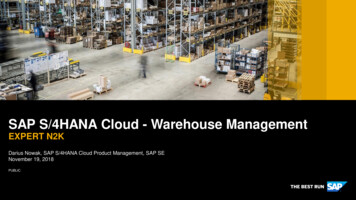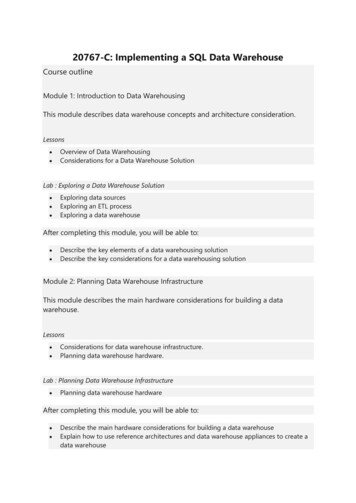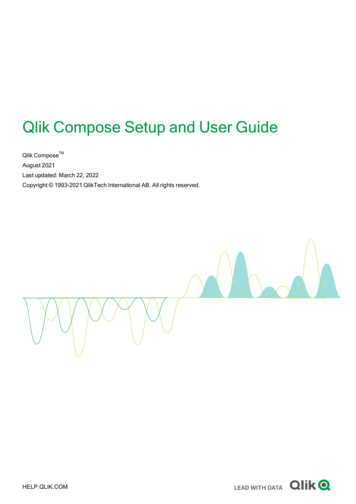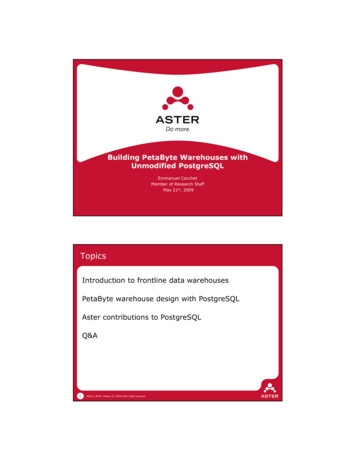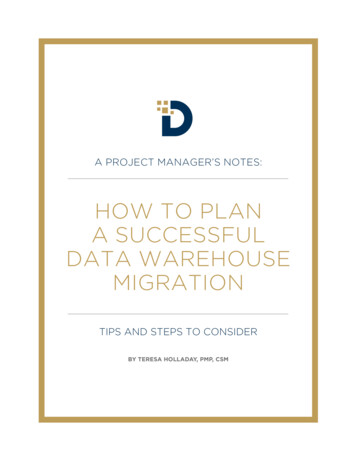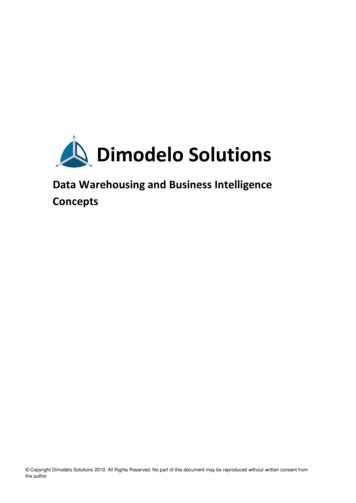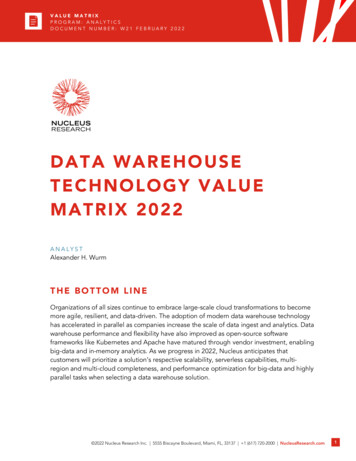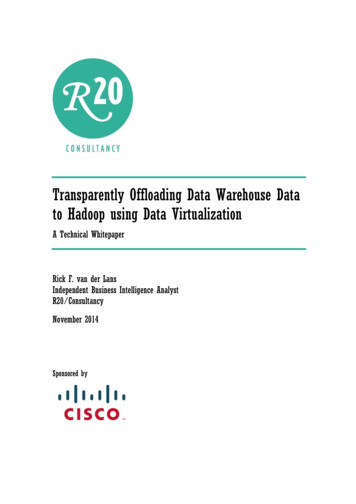
Transcription
Transparently Offloading Data Warehouse Datato Hadoop using Data VirtualizationA Technical WhitepaperRick F. van der LansIndependent Business Intelligence AnalystR20/ConsultancyNovember 2014Sponsored by
Copyright 2014 R20/Consultancy. All rights reserved. Cisco and the Cisco logo are trademarks orregistered trademarks of Cisco and/or its affiliates in the U.S. or there countries. To view a list of Ciscotrademarks, go to this URL: www.cisco.com/go/trademarks. Trademarks of companies referenced in thisdocument are the sole property of their respective owners.
Table of Contents1Introduction12The Ever-Growing Data Warehouse13Overview of Hadoop34The Data Warehouse Environment and Hadoop55Examples of Offloadable Data86Steps for Offloading Data Warehouse Data to Hadoop9Step 1: Identifying Offloadable DataStep 2: Installing HadoopStep 3: Importing Tables in CISStep 4: Migrating Reports to CISStep 5: Creating Tables in HadoopStep 6: Extending Views to Include the Hadoop TablesStep 7: Collecting Statistical Data on Offloadable DataStep 8: Initial Offloading of Data to HadoopStep 9: Refresh of the Offloaded DataStep 10: Testing the Report ResultsStep 11: Adapting the Backup Process9121313151517182121227Getting Started22About the Author Rick F. van der Lans24About Cisco Systems, Inc.24Copyright 2014 R20/Consultancy, all rights reserved.
Transparently Offloading Data Warehouse Data to Hadoop using Data Virtualization11 IntroductionThis whitepaper focuses on introducing the popular Hadoop data storage technology in an existing datawarehouse environment with the intention to use it as a platform for data offloading. The primary reasonsto offload data from current SQL database servers to Hadoop is to reduce storage costs and to speed upreports. The result is a data warehouse environment in which data is distributed across multiple datastorage technologies.The Cisco Information Server (CIS) data virtualization server is used to hide this hybrid data storagesystem. It allows organizations to migrate transparently from their single data storage solution to a hybridstorage system. Users and reports won’t notice this offloading of data.The whitepaper describes, step by step, how to introduce Hadoop in an existing data warehouseenvironment. Guidelines, do’s and don’ts, and best practices are included.As a complementary offering, Cisco also provides a packaged solution called Cisco Big Data WarehouseExpansion, which includes software, hardware, and services required to accelerate all the activitiesinvolved in offloading data from a data warehouse to Hadoop.2 The Ever-Growing Data WarehouseMore, More, and More – Most data warehouse environments use the once‐in‐never‐out principle to storedata. In most environments there is no intention to move data from the data warehouse to an archive orto remove it entirely. When new invoice, customer, or sales data is added, old data is not removed tomake room. Some data warehouses contain data that is more than twenty years old and that’s barely everused.But it’s not only new data coming from existing data sources that enlarges a data warehouse. New datasources are continuously introduced as well. An organization develops a new Internet‐based transactionsystem, acquires a new marketing system, or installs a new CRM system; all the data produced by thesenew systems must be copied to the data warehouse enlarging it even further.Besides new internal data sources, it has become very common to add data from external data sources,such as data from social media networks, open data sources, and public web services. Especially forspecific forms of analytics, enriching internal data with external data can be very insightful. Again, all thisexternal data is stored in the data warehouse environment.All this new data and all these new data sources lead to data warehouse environments that keep growing.The Drawbacks of an Ever-Growing Data Warehouse – In principle, data growth is a good thing. When more datais available for analysts and business users, their reporting and analytical capabilities increase. More datapotentially increases the reporting and analytical capabilities of an organization.Copyright 2014 R20/Consultancy, all rights reserved.
Transparently Offloading Data Warehouse Data to Hadoop using Data Virtualization2However, there are some practical drawbacks: Expensive data storage: Storing data in databases costs money. Examples of data storage costsare storage hardware costs, management costs, and license fees for those database serverespecially when the fee is dependent on the database size.Poor query performance: The bigger the tables in the data warehouse are, the slower thereporting queries will be.Poor loading performance: Loading new data may slow down when tables become bigger.Especially the indexes on the tables that must be updated when the data is loaded, can have anegative effect on the loading speed.Slow backup/recovery: The larger a database is, the longer the backup process and an eventualrestore of all the data takes.Expensive database administration: The larger a database is, the more time‐consuming databaseadministration will be. More and more time must be spent on tuning and optimizing the databaseserver, the tables, the buffer, and so on.The Solutions – There are several solutions to shrink a data warehouse environment: Removing Data: Periodically, delete some of the least‐used or the less‐recently used data to keepthe data warehouse environment as small as possible. The drawback of this approach is thatanalysis of the deleted data is no longer possible, limiting, in particular, historical analysis. Moving Data to an Offline Archive: Periodically, move unused or little used data to an offline datastorage system in which the data is not available online. This solution keeps the data warehouseenvironment small. The challenge is to “reanimate” offline data quickly and easily for incidentalanalysis. A crucial question to answer is whether the offline data should be reloaded in the datawarehouse, or should it temporarily be copied to a separate database? In principle, this doesn’treduce the amount of data stored, it’s just that a portion is stored outside the data warehouse. Offloading Data to an Inexpensive Online Data Storage System: Move a portion of the data to anonline data storage system with another set of technical characteristics. Obviously, such a datastorage system must support online queries, and there should be no need to “reanimate” the databefore it can be used for analysis. Storing data should also be less expensive. The result is a hybriddata warehouse environment in which all the stored data is distributed over different datastorage technologies.For most organizations, the third solution is preferred.Solving the Data Warehouse Growing Pains with Hadoop – One of the newest data storage technologies isHadoop. Hadoop has been designed to handle massive amounts of stored data, it has been optimized toprocess complex queries efficiently, it supports a wide range of application areas, and it has a lowprice/performance ratio. Especially the latter characteristic makes Hadoop an attractive data storageplatform to operate side by side with the familiar SQL database technology. Because the financial andtechnical characteristics of Hadoop are very different from those of SQL database technologies, it allowsdesigners to choose the best fit for each data set. For example, if query speed is crucial, SQL may beselected, and when storage costs must be reduced, Hadoop can be chosen. In other words, designers cango for the best of both worlds.Copyright 2014 R20/Consultancy, all rights reserved.
Transparently Offloading Data Warehouse Data to Hadoop using Data Virtualization3Hiding the Hybrid Data Storage System with Data Virtualization – SQL database technology is used in almost allthe data warehouses to store data. When data is offloaded to Hadoop, the data warehouse environmentdeploys both data storage systems: Hadoop and SQL database technology. The consequence is thatreports and users have to use different APIs and languages depending on where data is stored. Such APIsmust be studied in detail. Especially the traditional Hadoop APIs, such as HDFS, HBase, and MapReduce,are very technical and complex. Also, in such a new situation, reports and users must know in whichstorage system the data resides that they want to analyze. All this will raise the costs of reportdevelopment and maintenance. Finally, many reporting and analytical tools do not support access toHadoop. This means that users have to learn how to work with new reporting tools and that existingreports must be redeveloped.A data virtualization server decouples the two data storage systems from the reports, presenting oneintegrated data storage environment. In fact, with data virtualization the reports and users won’t noticethat data has been offloaded to another system. Users don’t have to learn new APIs or languages and theydon’t have to know in which system the data resides. Data virtualization fully hides the hybrid datastorage system. More on this in Section 4.3 Overview of HadoopIntroduction to Hadoop – Apache Hadoop has been designed to store, process, and analyze large amounts ofdata from terabytes to petabytes and beyond, and to process data in parallel on a hardware platformconsisting of inexpensive commodity computers. It consists of a set of software modules from which thedevelopers can pick and choose. Figure 1 illustrates the Hadoop modules on which this whitepaperfocuses.Figure 1 Hadoop consists of a number of modules including HDFS, YARN,MapReduce, HBase, and Hive (the light blue boxes).Copyright 2014 R20/Consultancy, all rights reserved.
Transparently Offloading Data Warehouse Data to Hadoop using Data Virtualization4The core modules are briefly introduced here. For more extensive descriptions, we refer to Tom White’sbook1 on Hadoop. HDFS: The Hadoop Distributed File System (HDFS) forms the foundation of Hadoop. This module isresponsible for storing and retrieving data. It’s designed and optimized to deal with large amountsof incoming data per second and to manage enormous amounts of data up to petabytes. YARN: YARN (Yet Another Resource Negotiator) is a resource manager responsible for processingall requests to HDFS correctly and for distributing resource usage correctly. Like all other resourcemanagers, its task is to assure that the overall performance is stable and predictable. MapReduce: MapReduce offers a programming interface for developers to write applications thatquery data stored in HDFS. MapReduce can efficiently distribute query processing over hundredsof nodes. It pushes any form of processing to the data itself, and thus parallelizes the executionand minimizes data transport within the system. MapReduce has a batch‐oriented style of queryprocessing. HBase: The HBase module is designed for applications that need random, real‐time, read/writeaccess to data. HBase has an API consisting of operations such as insert record, get record, andupdate record. HBase is usually categorized as a NoSQL system2. Hive: The Hive module is a so‐called SQL‐on‐Hadoop engine and offers a SQL interface on datastored in HDFS. It uses MapReduce or HBase to access the data. In case of the former, Hivetranslates each SQL statement to a MapReduce job that executes the request. Hive was the firstSQL‐on‐Hadoop engine. Nowadays, alternative products are available, including Apache Drill,Cloudera Impala, and Spark SQL.The Strengths of Hadoop High data storage scalability: HDFS has been designed and optimized to handle extremely largefiles. In real life projects, Hadoop has repeatedly proven that it’s able to store, process, analyze,and manage big data. High data processing scalability: Hadoop has been designed specifically to operate in highlydistributed environments in which it can exploit large numbers of nodes and drives. For example,one hundred drives working at the same time can read one terabyte of data in two minutes. Inaddition, MapReduce processing is moved to the nodes where the data is located. There is almostno centralized component that could become a bottleneck and lead to performance degradation. High performance: Together with HDFS, MapReduce offers high performance reporting andanalytics. One of the features of HDFS is data replication, which makes concurrent access to thesame data (on different nodes) possible.1White, T., Hadoop, The Definitive Guide, O’Reilly Media, 2012, third edition.Redmond, E. and Wilson, J.R., Seven Databases in Seven Weeks: A Guide to Modern Databases and the NoSQL Movement,Pragmatic Bookshelf, 2012.2Copyright 2014 R20/Consultancy, all rights reserved.
Transparently Offloading Data Warehouse Data to Hadoop using Data Virtualization5 Low price/performance ratio: Hadoop has been designed to exploit inexpensive commodityhardware. The license fees of commercial Hadoop vendors are not based on the amount of datastored. All data types: HDFS is a file system that can store any type of data, including weblogs, emails, orrecords with sensor data. In addition, functions can be developed in MapReduce that have thesame complexity found in SQL statements and beyond. MapReduce is not limited to structureddata. MapReduce allows applications to access any form of data. For example, complex functionscan be developed to analyze text or complex weblog records. If programmed correctly,MapReduce is able to process these complex functions completely in parallel, thus distributingthis complex and I/O and resource intensive processing over a large set of nodes. Fast loading: HDFS has been designed to load massive amounts of data in real‐time or in batch.Summary – Especially the low price/performance ratio and the high scalability features make Hadoop anideal platform for storing offloaded many types of data currently stored in the data warehouseenvironment.4 The Data Warehouse Environment and HadoopThe Databases of a Data Warehouse Environment – Traditionally, a data warehouse environment consists ofseveral databases, such as a staging area, a central data warehouse, and many data marts; see Figure 2. Inmost environments, all these databases are implemented using SQL database server products, such asOracle, Teradata, IBM PureData System for Analytics (formerly Netezza), or Microsoft SQL Server.Figure 2 Traditionally a datawarehouse environmentconsists of several databases.Note that most data is stored redundantly in a data warehouse environment. For example, data comingfrom the source systems is first stored in a staging area, then copied to a data warehouse, and from therecopied to one or more data marts. In the latter case, the data is usually stored in a slightly aggregatedform, but it’s still redundant data.Copyright 2014 R20/Consultancy, all rights reserved.
Transparently Offloading Data Warehouse Data to Hadoop using Data Virtualization6From SQL to Hadoop – As indicated in Section 3, the low price/performance ratio and the high scalabilityfeatures make Hadoop an ideal platform for storing data warehouse data. Several application areas existto deploy Hadoop in a data warehouse environment. For example, Hadoop can be used to develop a sandbox for data scientists, or it can be used to store massive amounts of textual data. And, it can be deployedto lessen the growing pains of a data warehouse environment. By moving some of the data from the SQLdatabases to Hadoop, organizations can deal with the data growth more easily.In general, there are two ways to migrate data to Hadoop: entire tables or partial tables.Entire tables: Offloading entire tables to Hadoop implies that some of the tables in a SQL database (forexample, the data warehouse itself) are moved completely to Hadoop; see Figure 3. After migrating thetables, the SQL database contains less tables. Reasons to offload an entire table are, for example, that thetable is not used frequently, or the data is massive and thus too expensive to store in the SQL database.Figure 3 Entire tables are moved from aSQL database to Hadoop.Partial tables: Offloading partial tables means that only a part of a table is offloaded. For example, for anumber of tables in a SQL database a subset of the records is moved to a table in Hadoop; see Figure 4.Afterwards, the SQL database still contains all the tables it owned before, it’s just that the tables don’tcontain all the records anymore. The rest of the records is stored in Hadoop. Reasons for offloading apartial table are, for example, that little‐used or unused records in a table can be identified, or that thetable is just massive.In Figure 4, an alternative to offloading a subset of the rows is offloading a subset of the columns. This canbe useful when some columns are barely ever used, or when they contain very large values, such asimages and videos. In this case, moving those columns to Hadoop may be more cost‐effective.Copyright 2014 R20/Consultancy, all rights reserved.
Transparently Offloading Data Warehouse Data to Hadoop using Data Virtualization7Figure 4 Offloading partial tables means that a subset of the records is moved from a SQL table to a Hadoop table.A Hybrid Data Storage System – Offloading data to Hadoop results in a hybrid data storage system wheresome data is stored in SQL databases and some in Hadoop. Depending on the data and reportingcharacteristics, data resides in one of the two storage systems. This means, for example, when data isoffloaded from a SQL database (that holds the central data warehouse) to Hadoop, that the datawarehouse is no longer one physical database anymore.The consequence of such a hybrid data storage system is that applications must know in which datastorage system the data resides that they need, they must know which records or columns of a tablereside in which storage system, they must know when data moves from one data storage system toanother, and they must understand the different APIs and languages supported by the storage systems.And as already indicated, Hadoop APIs, such as HDFS, HBase, and MapReduce, are very technical andcomplex. Skills to work with these APIs are not commonly found in BI departments.Data Virtualization and the Hybrid Data Storage System – All these technical aspects, such as handling differentAPIs, being location and SQL dialect aware, slow down report development and complicate maintenance.In particular for self‐service BI users, this may all be too complex, possibly leading to incorrect reportresults.Also important to note is that popular reporting and analytical tools typically support SQL but not Hadoopinterfaces, such as HDFS, HBase, and MapReduce. This makes it difficult and maybe even impossible touse familiar tools on the data stored in Hadoop. This leads to redevelopment of existing reports using newtools.These problems can be solved by placing CIS between, on the one hand, all the applications and reportingtools, and, on the other hand, all the SQL databases and Hadoop; see Figure 5. This way, reports and usersstill see one integrated database. CIS completely hides the hybrid data storage system. With datavirtualization, the location of the data, APIs, and dialect differences are fully hidden. Users and reportsdon’t have to know where or how tables are stored, they don’t have to know where records are stored,Copyright 2014 R20/Consultancy, all rights reserved.
Transparently Offloading Data Warehouse Data to Hadoop using Data Virtualization8and users can continue using their favorite reporting tools and reports don’t need to be redeveloped. Inaddition, CIS makes a transparent migration to a hybrid storage environment possible. The users won’tnotice the offloading of data to Hadoop.Figure 5 By hiding all the technicaldetails, CIS turns the hybrid datastorage system into one integrateddatabase.5 Examples of Offloadable DataInfrequently‐used data is the first type of data that comes to mind for offloading to Hadoop. But manymore types of data exist that are well suited for offloading. This section contains examples of types of datathat organizations may consider for offloading to Hadoop.Massive Fact Data – Some tables can be just massive in size. For example, tables in a data warehousecontaining call‐detail records or sensor data may contain billions and billions of records. Purely because ofthe sheer size of those tables and possibly also the ingestion rate of new data, it’s recommended to movethese tables to Hadoop. These massive tables are almost always fact tables.Semi-Structured Data – Nowadays, a lot of new data comes in a semi‐structured form, for example, in theform of XML or JSON documents. Technically, it’s possible to store such documents in SQL tables, butaccess is not always fast, and transforming it to flat table structures may be time‐consuming duringloading. Hadoop allows data to be stored in its original form. In fact, it supports file formats specificallydeveloped for these forms of data.Textual Data – As with semi‐structured data, textual data, such as emails, agreements, and social mediamessages, can be stored in SQL tables. However, it may be more cost‐effective to store this type of data inHadoop.Copyright 2014 R20/Consultancy, all rights reserved.
Transparently Offloading Data Warehouse Data to Hadoop using Data Virtualization9Audio/Video Data – In many BI environments, audio and video data is not analyzed at all. Most reportingand analytical tools can’t exploit them at all. For example, current BI tools do not have the features todetect cancer in MRI scans, to count the germs in a swab, to do optical character recognition, or toidentify microstructural flaws in steel. Plus, storing this type of data in a SQL database is quite expensive.Dedicated tools to analyze this data do exist, and most of them work quite well with Hadoop.Cold Data – Many tables contain records or columns that are, for whatever reason, rarely ever used. Colddata can be defined as data that was entered a long time ago and that has been used infrequently for aconsiderable amount of time. In a way, cold data is like the junk you have lying around in your garage andthat you haven’t used in ages, but is still there and is filling up your garage so that your car and barbecueare outside in the rain corroding away.Obsolete Data – Tables may also contain data that has become irrelevant for most users of the organization:obsolete data. This can be, for example, descriptive data on obsolete sales products, or sales data relatedto retail shops that have been closed down. Obsolete data cannot be thrown away. It may still benecessary for compliancy reasons. Because of its very low data usage, it makes sense to offload obsoletedata to Hadoop.6 Steps for Offloading Data Warehouse Data to HadoopThis section describes step by step how to offload data from one or more of the SQL databases in a datawarehouse environment, such as the data warehouse or data mart, and how to move that data toHadoop. These are the steps:1.2.3.4.5.6.7.8.9.10.11.Identifying offloadable dataInstalling HadoopImporting tables in CISMigrating reports to CISCreating tables in HadoopExtending views to include the Hadoop tablesCollecting statistical data on offloadable dataInitial offloading of data to HadoopRefresh of the offloaded dataTesting the report resultsAdapting the backup processWe assume that all the databases making up the data warehouse environment are developed with a SQLdatabase server, such as Oracle, Teradata, IBM PureData System for Analytics (formerly Netezza), orMicrosoft SQL Server.Step 1: Identifying Offloadable DataIt all starts with identifying offloadable data. This sounds simple, but it isn’t, because the identifyingprocess is not an exact science. For example, when is data cold or warm? There is always a set of recordsCopyright 2014 R20/Consultancy, all rights reserved.
Transparently Offloading Data Warehouse Data to Hadoop using Data Virtualization10that is lukewarm. Or, how much textual data financially justifies its offloading to Hadoop? When is datareally obsolete? To assist, guidelines are given in this section to identify offloadable data.Massive Fact Data – The very large tables in a data warehouse or data mart are almost always fact tables.Evaluate if some of them can be offloaded entirely. For this, study their query and load workload. Here aresome reasons to offload a massive fact table: When the SQL database server is starting to have performance problems with loading new data inthe fact table. Hadoop’s load speed may be faster.When overall the queries on the fact table are showing performance problems due primarily tothe number of records.When it’s becoming too expensive to store the entire fact table in the SQL database server.When the query workload can be characterized as interactive reporting and analysis, be careful withoffloading to Hadoop, because Hadoop’s support of this type of analysis leaves much to be desired. Ifmost of the reporting is much more traditional, then consider offloading data.When it’s not an option to offload the entire table, offload a subset of the cold records; see the next topic.Cold Data – Section 5 contains a definition of cold data: data that was entered a long time ago and that hasbeen used infrequently for a considerable amount of time. Unfortunately, all the concepts used in thedefinition of cold data are vague. What is a long time ago? What is used infrequently? What is aconsiderable amount of time? To answer such questions, the usage of data usage must be analyzed indetail. A data usage analysis must show how often tables are queried, how often individual records andcolumns are queried, how often data is inserted, and how many users use certain records or columns. Themore questions of this kind are answered, the more complete the data usage analysis will be, and themore easy it is to determine the temperature of the data.Data usage can be determined with custom‐developed tools or with dedicated monitors. Most SQLdatabase servers support monitors that show data usage. Unfortunately, most of them do not show datausage on the level of detail required for analyzing data usage. Most of these tools only show usage pertable or per column. In an ideal situation data usage analysis shows query usage per day; see Figure 6 asan example. In this diagram, the curved, black line indicates how infrequently older records are still beingused and how frequently the newer ones. The alternative purple curve indicates another form of datausage where even older records are still being used frequently. In this case, offloading records probablydoesn’t make sense.Based on the data usage results, define the crossover point (the dotted line in Figure 6). The crossoverpoint is the age that divides the cold data from the warm data. In most cases it’s easy to identify the reallycold and the really warm records of a table, but there is always this group of records that is neither warmnor cold. In case of doubt, define these records as warm and don’t offload them.Copyright 2014 R20/Consultancy, all rights reserved.
Transparently Offloading Data Warehouse Data to Hadoop using Data Virtualization11Figure 6 A data usage analysisexercise can result in a clearpresentation of usage of individualrecords. It shows which records in atable may be considered foroffloading.When defining a crossover point, be careful with the following aspects: The crossover point is not a date, but an age.The crossover point may change over time. For example, initially an age of two years is identifiedas the crossover point, which must be changed to three years later on. The reason may be thatusers have started to run more forms of historical analysis leading to a change of data usage. Thismay slide the crossover point to an older age (to the left in Figure 6).Some records that have come of age and have clearly passed the crossover point may be very hotrecords. These records are called outliers. Analyze if there are outliers in tables whose usage issignificantly higher than records with approximately the same age. In this case, identify them andchange the crossover point accordingly.Sometimes an entire column contains cold data. They contain data that’s barely ever or never used at all.In this case, no crossover point is required. Especially offloading “wide” columns can be useful. Examplesof wide columns are columns containing long text blocks, images, scanned documents, or videos. In caseof an offloadable column, indicating the columns name is sufficient.Obsolete Data – Because of its very low data usage, offload obsolete data. The difference between obsoletedata and cold data is that for the latter an age‐related crossover point is defined, whereas obsolete datehas no relationship to the concept of age.For obsolete records a criterion indicates the ones that are obsolete. An example of such a criterion is anindication of whether a shop has been closed. Or, all the values of a column may be obsolete when itcontains characteristics of a product that are not in use anymore.Audio/Video Data – Audio and video data is barely ever used for reporting and analysis. As indicated, mostreporting tools do not even have features to analyze them. To reduce the size of the data warehouse, it’sstrongly recommended to offload all this data to Hadoop. Especially if separate tables have been createdin a data warehouse to store these large values, offloading them entirely to Hadoop is a relatively simpleexercise. In addition, in many situations this type of data is only used by a small group of users, but it maystill be in the way for other users.Copyright 2014 R20/Consultancy, all rights reserved.
Transparently Offloading Data Warehouse Data to Hadoop using Data Virtualization12An additional advantage of moving audio and video data to Hadoop is that specialized tools may beavailable to analyze th
involved in offloading data from a data warehouse to Hadoop. 2 The Ever-Growing Data Warehouse More, More, and More - Most data warehouse environments use the once‐in‐never‐out principle to store data. In most environments there is no intention to move data from the data warehouse to an archive or

